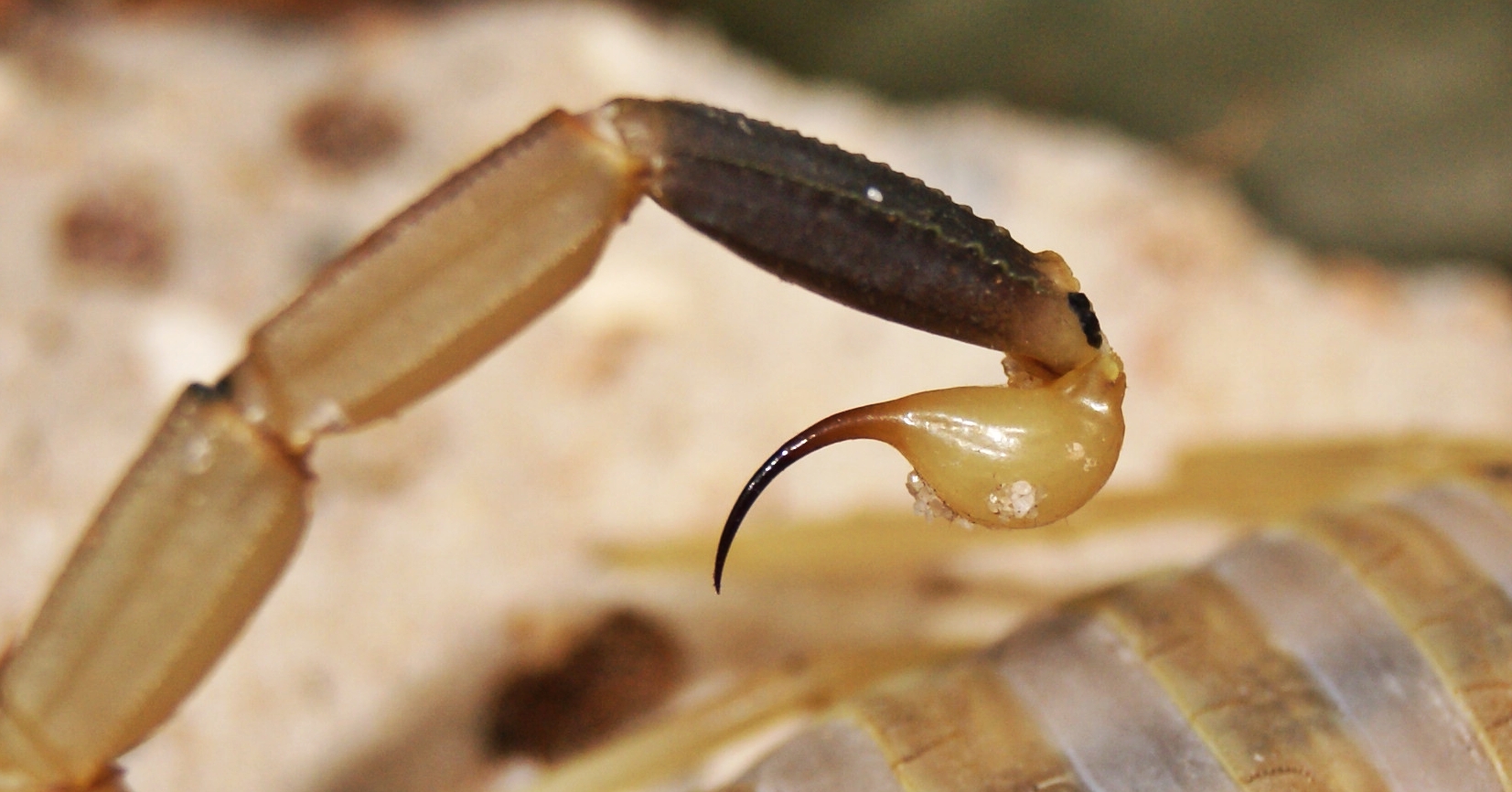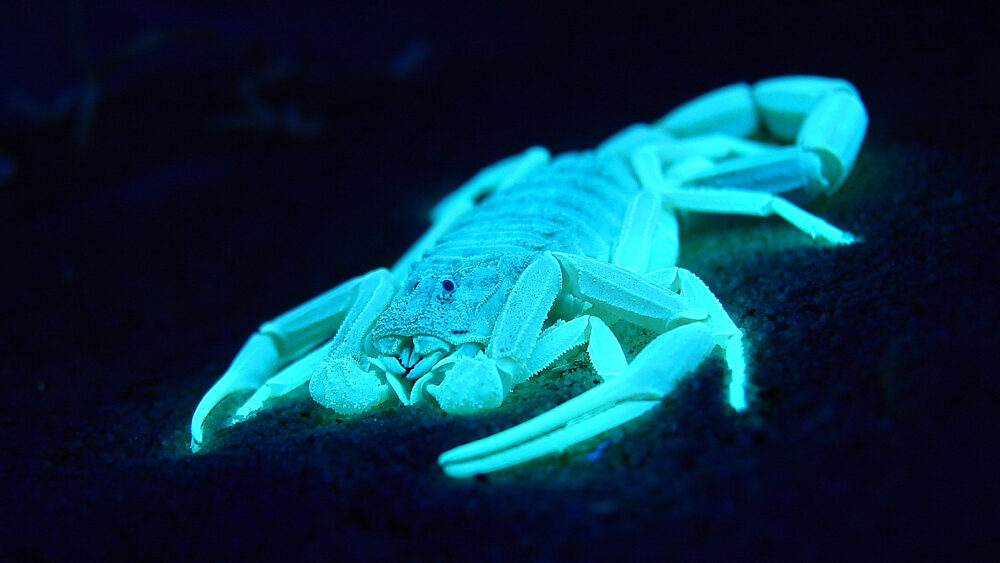In the harsh deserts of North Africa and the Middle East, where temperatures soar during the day and plummet at night, one of nature’s most feared predators lurks beneath rocks and in sandy crevices. The deathstalker scorpion, with its menacing pincers and venom-loaded tail, has terrorized desert dwellers for centuries. Yet this same creature, whose sting can kill a human within hours, might hold the key to saving millions of lives through revolutionary cancer treatment. Scientists have discovered that components within this deadly venom can actually illuminate cancer cells like a biological spotlight, making them easier to detect and destroy. This remarkable discovery transforms our understanding of how nature’s most dangerous toxins might become medicine’s most powerful allies.
The Desert’s Most Feared Predator

The deathstalker scorpion, scientifically known as Leiurus quinquestriatus, stands as one of the most venomous creatures on Earth. This pale yellow arachnid measures just 3 to 4 inches long, yet its sting carries enough potent toxins to kill an adult human.
Found across the arid landscapes of North Africa and the Middle East, these scorpions have perfected their hunting techniques over millions of years. Their venom evolved not just to kill prey, but to do so with surgical precision, targeting specific cellular pathways that control nerve function and muscle movement.
What makes the deathstalker particularly dangerous is its aggressive nature and tendency to hide in unexpected places. Unlike many scorpions that prefer to flee when threatened, deathstalkers often stand their ground, raising their tails in a defensive posture that signals imminent danger to any creature foolish enough to approach.
The Science Behind the Sting

Deathstalker venom represents a complex cocktail of over 100 different compounds, each serving a specific biological purpose. The most studied component, chlorotoxin, makes up just a small fraction of the total venom but proves to be the most medically significant.
This protein targets specific ion channels in cell membranes, particularly those found in nerve and muscle tissue. When injected into a victim, chlorotoxin disrupts the normal flow of sodium and chloride ions, causing paralysis and eventual death.
The venom’s effectiveness comes from its ability to cross the blood-brain barrier, something that most substances cannot do. This property, which makes the sting so deadly, also makes it incredibly valuable for medical research focused on brain-related diseases.
From Killer to Healer

The transformation of deathstalker venom from a weapon of death to a tool of healing began with a serendipitous discovery in the 1990s. Researchers studying the venom’s effects on brain tissue noticed something unexpected: certain components seemed to bind selectively to cancerous cells.
This selectivity fascinated scientists because cancer cells often share characteristics with rapidly dividing normal cells, making them difficult to target specifically. The fact that scorpion venom could distinguish between healthy and malignant tissue opened up entirely new possibilities for cancer treatment.
Further investigation revealed that chlorotoxin has an affinity for a protein called matrix metalloproteinase-2 (MMP-2), which is overexpressed in many types of cancer cells. This discovery laid the groundwork for developing targeted cancer therapies based on scorpion venom.
Illuminating the Invisible Enemy

One of the most promising applications of deathstalker venom involves attaching fluorescent molecules to chlorotoxin, creating a biological beacon that lights up cancer cells. This technique, called tumor paint, allows surgeons to see exactly where cancer cells are located during operations.
The process works by injecting the fluorescent chlorotoxin into a patient’s bloodstream hours before surgery. The compound circulates throughout the body, but only binds to cancer cells, causing them to glow under special lighting.
This innovation addresses one of the biggest challenges in cancer surgery: determining the exact boundaries of tumors. Traditional methods often leave microscopic cancer cells behind, leading to recurrence, while this new technique helps ensure complete removal of malignant tissue.
Brain Cancer Breakthrough

Brain tumors present particularly challenging treatment scenarios because the blood-brain barrier prevents most chemotherapy drugs from reaching their target. Deathstalker venom’s natural ability to cross this barrier makes it uniquely suited for treating brain cancers.
Clinical trials using chlorotoxin-based treatments have shown remarkable promise in patients with glioblastoma, one of the most aggressive forms of brain cancer. The venom component not only helps locate tumor cells but can also be used to deliver targeted therapies directly to the cancer site.
Researchers have developed various delivery systems, including nanoparticles loaded with chemotherapy drugs and guided by chlorotoxin. These microscopic vehicles can navigate through the bloodstream, cross the blood-brain barrier, and release their payload specifically at tumor sites.
The Molecular Mechanism

Understanding exactly how chlorotoxin works at the molecular level has been crucial for developing effective treatments. The protein binds to specific receptors on cancer cell surfaces, particularly those involved in cell invasion and metastasis.
Once bound, chlorotoxin can interfere with the cancer cell’s ability to spread to other parts of the body. This anti-metastatic effect occurs because the venom component blocks certain signaling pathways that cancer cells use to break away from primary tumors.
The binding process also makes cancer cells more vulnerable to other treatments, potentially enhancing the effectiveness of traditional chemotherapy and radiation therapy. This synergistic effect means that lower doses of conventional treatments might be needed, reducing side effects for patients.
Engineering Nature’s Solution

While natural chlorotoxin shows great promise, scientists have worked to improve its effectiveness through genetic engineering. By modifying the protein’s structure, researchers can enhance its binding affinity for cancer cells while reducing potential side effects.
Synthetic versions of chlorotoxin have been developed that are more stable and easier to manufacture than the natural compound. These engineered proteins can be produced in large quantities using bacterial or yeast cell cultures, making them more accessible for clinical use.
Some modified versions include additional targeting sequences that make them even more specific for certain types of cancer. These improvements represent a perfect marriage between nature’s ingenuity and human innovation.
Clinical Trials and Real Results

Several clinical trials have tested chlorotoxin-based treatments in human patients, with encouraging results. Phase I and II trials have demonstrated the safety and efficacy of tumor paint in various types of cancer, including brain tumors, skin cancers, and certain solid tumors.
One particularly successful trial involved patients with brain tumors who received fluorescent chlorotoxin before surgery. Surgeons reported being able to identify and remove cancerous tissue with unprecedented precision, leading to better outcomes and fewer complications.
The treatments have shown minimal side effects compared to traditional chemotherapy, largely because they target cancer cells specifically rather than affecting healthy tissue. This selectivity represents a major advantage in cancer treatment, where the goal is to destroy malignant cells while preserving normal ones.
Beyond Brain Cancer

More of my work can be found in Category:Files by User:ST.
If you use my work outside Wikimedia I would appreciate being notified and referred to site where used here., Attribution, https://commons.wikimedia.org/w/index.php?curid=1979172)
While much of the research has focused on brain tumors, chlorotoxin shows promise for treating other types of cancer as well. Studies have demonstrated its effectiveness against prostate cancer, lung cancer, and certain types of lymphoma.
The versatility of chlorotoxin comes from the fact that many different cancers overexpress the same proteins that the venom component targets. This means that a single treatment approach could potentially be used against multiple types of cancer.
Researchers are also exploring combination therapies that use chlorotoxin alongside other treatments. These approaches could involve using the venom component to deliver multiple drugs simultaneously or to sensitize cancer cells to other therapeutic interventions.
The Challenge of Production
One of the biggest hurdles in developing chlorotoxin-based treatments is producing enough of the compound for widespread clinical use. Extracting venom from live scorpions is dangerous, time-consuming, and yields only tiny amounts of the desired protein.
Modern biotechnology has provided solutions through recombinant DNA technology, allowing scientists to produce large quantities of chlorotoxin in laboratory settings. Bacteria, yeast, and even plant cells can be genetically modified to produce the protein efficiently and safely.
These production methods have made it possible to conduct larger clinical trials and eventually bring chlorotoxin-based treatments to market. The scalability of biotechnological production ensures that successful treatments can be made available to patients worldwide.
Nature’s Pharmacy

The deathstalker scorpion represents just one example of how nature’s most dangerous creatures might hold keys to medical breakthroughs. Venoms from snakes, spiders, and other animals have contributed to the development of numerous life-saving medications.
This phenomenon occurs because venoms evolved to affect specific biological pathways, making them naturally suited for targeting disease processes. The specificity that makes venoms deadly also makes them potentially therapeutic when used correctly.
The success of chlorotoxin research has inspired scientists to investigate other venomous animals for potential medical applications. This growing field, called venomics, represents a new frontier in drug discovery that could yield countless new treatments.
Future Possibilities
The future of chlorotoxin-based cancer treatment looks incredibly promising, with researchers working on several exciting developments. Next-generation tumor paints could provide even more detailed visualization of cancer cells, potentially allowing for minimally invasive surgical procedures.
Scientists are also developing targeted drug delivery systems that use chlorotoxin to guide therapeutic nanoparticles directly to cancer sites. These systems could deliver higher concentrations of chemotherapy drugs while minimizing damage to healthy tissue.
Another promising direction involves using chlorotoxin to enhance immunotherapy treatments. By helping the immune system identify and attack cancer cells more effectively, venom-based treatments could boost the body’s natural defenses against malignant disease.
Ethical Considerations
The development of scorpion venom-based treatments raises important ethical questions about the use of animal-derived materials in medicine. While modern production methods don’t require harvesting venom from live animals, the initial research did involve capturing and milking scorpions.
Conservation concerns also arise as researchers study venomous animals for medical purposes. Increased interest in these creatures could lead to over-collection from wild populations, potentially threatening their survival in natural habitats.
However, the biotechnological production of chlorotoxin addresses many of these concerns by eliminating the need for animal harvesting. This approach allows for sustainable development of life-saving treatments while protecting wild scorpion populations.
The Road Ahead

As chlorotoxin-based treatments move closer to widespread clinical use, researchers continue to refine and improve these therapies. Current work focuses on optimizing dosing protocols, developing combination treatments, and expanding applications to new types of cancer.
Regulatory approval processes are underway for several chlorotoxin-based treatments, with some expected to reach the market within the next few years. This represents the culmination of decades of research that began with the simple observation that scorpion venom could distinguish between healthy and cancerous cells.
The journey from deadly desert predator to life-saving medical treatment illustrates the incredible potential hidden within nature’s most feared creatures. What once spelled certain death now offers hope to millions of cancer patients worldwide. The deathstalker scorpion’s venom, refined through millions of years of evolution to be the perfect killer, has been transformed by human ingenuity into a beacon of light in the fight against cancer. As we continue to unlock the secrets of nature’s pharmacy, we’re reminded that sometimes the most unlikely sources can provide the most powerful solutions. The next time you see a scorpion scuttling across the desert sand, remember that within its tiny body lies a compound that could save human lives – proving that in the grand tapestry of life, even our greatest enemies might become our most valuable allies.

